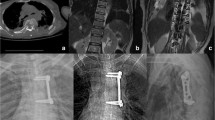Summary
Fourteen cases of an anterior inferior angle fracture of the axis treated in the Orthopaedic Department of the University of Athens from January 1970 to December 1992 were analysed. The mean follow-up time was 8.5 years. The so-called “tear drop” fracture of the axis composes a special entity characterised by an avulsed fragment, of varying size, from the anterior inferior angle of the body of the axis as a result of hyperextension. This type of injury is not a frequent one, representing 3% of the cervical spine trauma in our Department. There were eight men and six women with a mean age of 47 years. Road traffic accident is by far the most common mode of aetiology. The stability of this lesion is questioned by certain authors, resulting in disagreement concerning the choice of treatment to be followed. All the patients in our series were treated conservatively, consisting at the beginning with Glisson traction and then the use of a simple cervical collar. The rotation of the detached fragment, its anterior displacement, the posterior displacement of the vertebral body as well as the presence of instability at the C1-3 levels were analysed. The high incidence of co-existing lesions at the same or at a more distal level is discussed. This study revealed that there was no significant displacement of the vertebral body, and thus disturbance of the posterior ligaments, rendering the fracture stable. The rotation of the avulsed bony fragment along with its anterior displacement did not influence the final outcome. We believe that surgery has no place in the treatment for this injury.
Similar content being viewed by others
References
Aebi M, Nazarian S (1987) Klassifikation der Halswirbelsäulenverletzungen. Orthopäde 16:27–36
Barthelemy A (1979) Fractures en Tear Drop. In: Roy-Camille R (ed) Rachis Cervical traumatique non neurologique. Masson, Paris, pp 128–133
Bauer DR, Errico TJ (1991) Cervical spine injuries. Spinal trauma. J. B. Lippincott, Philadelphia, pp 71–121
Harris GH, Edeiken-Monroe B, Kopaniky DR (1986) A practical classification of acute cervical spine injuries. Orthop Clin North Am 17:15–30
Jakim I, Sweet MBE (1988) Transverse fracture through the body of the axis. J Bone Joint Surg [Br] 70:728–729
Korres DS, Kyritsis G, Kouvaras J, Sapkas G, Velikas EP (1987) Double level fractures of the cervical spine. Int Orthop (SICOT) 11:105–108
Levine AM, Edwards CC (1986) Treatment of injuries of the C1–C2 complex. Orthop Clin North Am 17:31–42
Maki NJ (1985) A transverse fracture through the body of the axis: a case report. Spine 10:857–859
Mazel C, Roy-Camille R (1990) Tear drop fractures of C2; pathogenesis and treatment. 7th Annual Meeting of C.S.R.S., Taormina, September 16–29
Schneider RC, Kahn EA (1956) Chronic neurological sequelae of acute trauma to the spine and spinal cord. I. The significance of the acute flexion or “tear drop” fracture dislocation of the cervical spine. J Bone Joint Surg [Am] 38:985–997
Shapiro R, Youngberg A, Rothman S (1973) the differential diagnosis of traumatic lesions of the occipital-atlanto-axial segment. Radiol Clin North Am XI:505–525
Author information
Authors and Affiliations
Rights and permissions
About this article
Cite this article
Korres, D.S., Zoubos, A.B., Kavadias, K. et al. The “tear drop” (or avulsed) fracture of the anterior inferior angle of the axis. Eur Spine J 3, 151–154 (1994). https://doi.org/10.1007/BF02190577
Issue Date:
DOI: https://doi.org/10.1007/BF02190577




